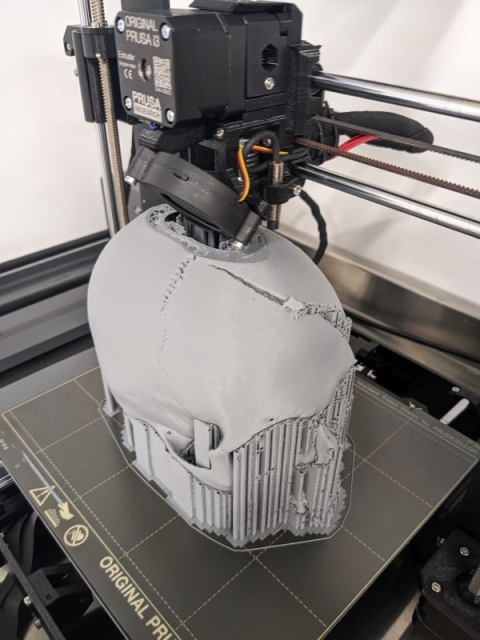An eight-week trial, which led to the murder conviction of five men, used a 3D-printed skull of the victim as evidence in court.
This unique evidence supported the pathologist's testimony and also allowed the jury to visualise trauma to the victim.
The skull was 3D printed by experts at the University of Portsmouth who worked in partnership with Hampshire and the Isle of Wight Constabulary's Imaging Unit.
The Imaging Unit created a digital model using data from a CT scan to show injuries sustained by the victim.
Dr Morgan Lowther, Senior Scientific Officer from the University of Portsmouth's School of Mechanical and Design Engineering, then worked on 3D printing the skull.
He said: "This was an unusual case because the victim had survived some very traumatic injuries and spent three months in hospital, before he sadly passed away. This meant that there were hospital quality X-ray scans of his injuries, which we could use to reconstruct the anatomy.
"Using the digital model provided by the hospital scans, we could 3D print a physical copy, building up material layer by layer. The exhibit was made from a material called PLA (polylactic acid), and by adding an internal scaffold, we made the anatomy stable enough to be handled and presented in court."

The skull was made from a material called PLA (polylactic acid)
Victim Frazer Brabant was found lying in the front garden with serious head injuries on Gershwin Road, Basingstoke, on 31 October 2019. He was taken to hospital where he remained in a coma until 21 January 2020 when he died. He was 31 years old.
A post-mortem examination found he had been struck multiple times to the head and face by a heavy, sharp-edged object described as a machete or sword type weapon. At least one of the blows caused catastrophic brain damage.
Four men were found guilty of murder and received life sentences at Winchester Crown Court on 14 July this year.
A fifth man was convicted of conspiracy to cause GBH with intent and sentenced to six years.
Dr Lowther continued: "I attended the trial and saw the pathologist use the model to help guide the jury through the injuries sustained by the victim. He was able to demonstrate the order in which the blows were likely to have occurred, whether they'd come at the same angle, and whether they would have come from the same assailant or the same weapon.
"The jurors were allowed to handle the model and take it into the deliberation room. I think it was a valuable piece of evidence to help them understand the severity of the attack."
The University already has a long and successful partnership with Hampshire and the Isle of Wight Constabulary, but this is the first-time experts have successfully printed 3D evidence that's made it to trial.
It's a truism that a picture is worth a thousand words - but a three-dimensional exhibit that the jury can handle, as they never could the real thing, is a perfect illustration.
Basil Purdue, Pathologist
Detective Sergeant Dan Hunt, the Investigating Officer, said: "This case was very complex and built over many years. It demonstrates how working in partnership can have a huge positive impact on justice and the lives of those we serve.
"The printing was initiated by one of our Imaging Technicians as a way of helping the investigation team present the case at court.
"We were able to work from data provided by a CT scan of the victim's skull and used 3D modelling software to create a digital model.
"This was then printed by the University of Portsmouth ready for trial.
"This printing was pivotal to our case having been accepted into the court, and subsequently the jury's deliberation room. This assisted us greatly in achieving justice for Frazer Brabant, his family and helped put offenders behind bars."
Pathologist Basil Purdue said: "It's a truism that a picture is worth a thousand words - but a three-dimensional exhibit that the jury can handle, as they never could the real thing, is a perfect illustration.
"This is the most impressive demonstration of 3D printing that I've seen. It was more than helpful in court."
Paul Taylor, the National Policing Chief Scientific Advisor, said: "This innovative use of 3D technology to explain evidence to jurors shows how policing is embracing the rapid developments in scanning and computer modelling capabilities to bring justice to victims. We are rapidly moving to a place where presentations of expert evidence can and should be more than 2D pictures. I anticipate 3D printing will continue to help make complex evidence more accessible for jurors in years to come.
The cross-pollination of ideas and expertise between forces and academia is crucial to creating innovative, workable solutions for policing and improving the criminal justice system. This collaboration between Hampshire and Isle of Wight Constabulary and the University of Portsmouth is an excellent example of just that."






